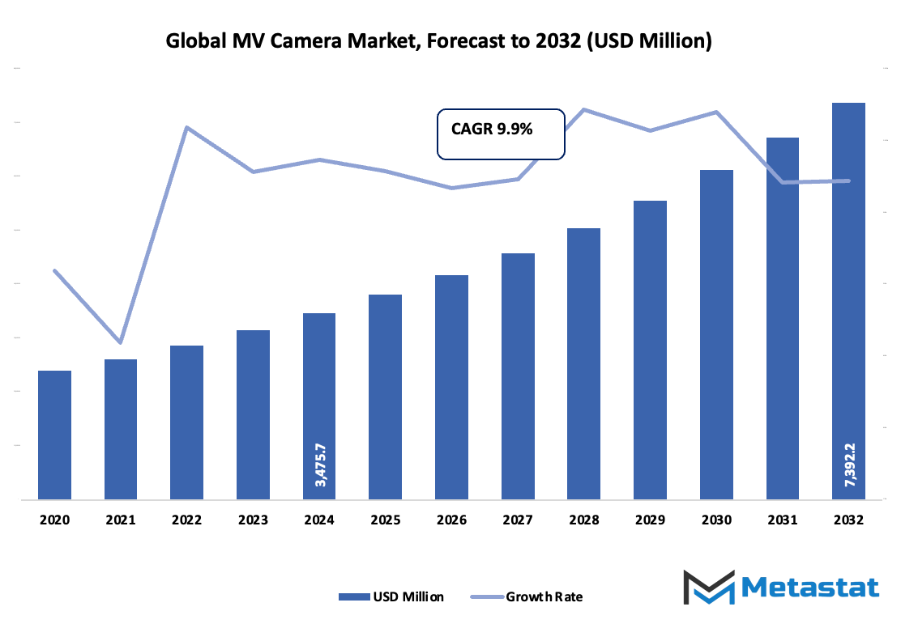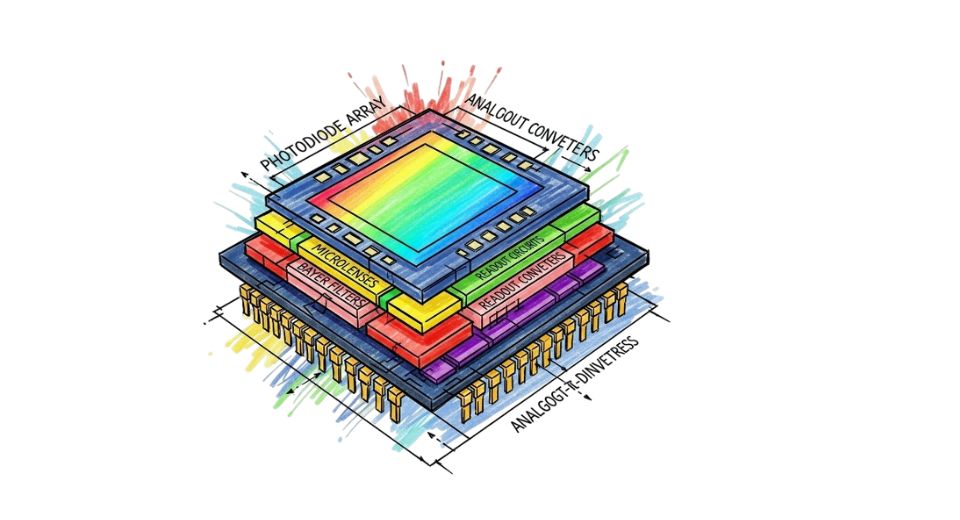Global MV Camera Market - Comprehensive Data-Driven Market Analysis & Strategic Outlook
The global mv camera market and its industry had humble beginnings that can be traced back to the late twentieth century when manufacturing plants first started experimenting with automated vision systems. At that time, cameras designed for industrial inspection were bulky, expensive, and often unreliable, but they marked the beginning of a transformation in how industries approached accuracy and speed. The earliest adoption was seen in automotive production lines where the need for consistency drove engineers to seek solutions beyond the limits of manual labour. These early systems were not widely adopted, but they created the foundation for what would later grow into a specialized sector of imaging technology.
- Global mv camera market worth nearly USD 3816.1 million in 2025, increasing at a CAGR of nearly 9.9% during 2032, with the potential to reach more than USD 7392.2 million.
- Less than 1 MP contributes almost 13.1% market share, leading innovation and widening applications through vigorous research.
- Major trends fuelling growth: Increasing use of machine vision systems in industrial automation, Increasing demand for quality inspection and defect detection in manufacturing
- Chances involve: Growing use of AI-based machine vision for smart factories
- Major insight: The market would witness exponential growth in value within the decade ahead, reflecting robust growth prospects.

In the 1990s, once digital sensors became more widely available, the global mv camera market made its first big leap forward. Miniature sensors with enhanced image quality enabled machine vision systems to spot defects and control robotics with greater accuracy. This is also when dedicated suppliers started to emerge, designing hardware specifically for factory application, instead of modifying consumer products. The 2000s saw another paradigm-shifting event with software algorithms that could analyze in real time combining with high-speed processors, making cameras decision-making instruments instead of being mere recorders. In later years, evolving customer demands for perfect products and narrower error margins forced industries to rely immensely on inspection systems driven by these cameras.
Regulatory shifts in industries such as pharmaceuticals and food packaging also increased the demand further, as governments asked for more stringent monitoring to meet safety and compliance. Concomitantly, technological developments in connectivity and computational power pushed manufacturers to incorporate mv cameras as part of larger automated systems, connecting them with robotics, conveyors, and cloud-based analytics. In the future, the market will keep up with the digital transformation of industries. Cameras will not only take pictures but will also provide predictive information by interfacing with artificial intelligence and deep learning systems.
What started as a mere attempt to substitute the human eye in mundane tasks will form itself into a web of smart devices that direct production, logistics, and even quality control at unprecedented scales. The history of the global mv camera industry is thus one of gradual adjustment, technological innovation, and constant reaction to the increasing expectations of both industry and society.
Market Segments
The global mv camera market is mainly classified based on Resolution, Sensor Type, Interface, Application.
By Resolution is further segmented into:
- Less than 1 MP: Cameras below 1 MP will continue to serve simple tasks where high detail is unnecessary. These cameras will remain cost-effective solutions for monitoring and basic inspections, supporting environments where efficiency is prioritized over image quality.
- 1 to 5 MP: Cameras with 1 to 5 MP will dominate moderate industrial and robotics applications. They will offer a balance between image clarity and data processing requirements, making them suitable for tasks that need decent resolution without heavy computational needs.
- 5 to 10 MP: Cameras in the 5 to 10 MP range will gain attention for applications requiring precision imaging. These cameras will allow detailed analysis in manufacturing and research sectors, supporting more sophisticated automation processes and higher accuracy in quality assessments.
- More than 10 MP: Cameras exceeding 10 MP will drive the future of advanced inspection and scientific imaging. These high-resolution devices will be critical for intricate measurement tasks, enabling deeper analysis and more reliable decision-making in industries that require extreme precision.
By Sensor Type the market is divided into:
- CCD (Charge-Coupled Device): CCD sensors will remain preferred for tasks needing uniform and high-quality image output. Their reliability and consistent performance make them suitable for precision inspection and controlled environments, ensuring accurate image capture.
- CMOS (Complementary Metal-Oxide-Semiconductor): CMOS sensors will see increased use due to faster processing and energy efficiency. They will support applications requiring rapid imaging, such as robotics and industrial automation, without compromising image quality in high-speed operations.
- EMCCD: EMCCD sensors will be essential for low-light and high-sensitivity imaging. These sensors will advance scientific research, medical imaging, and specialized industrial monitoring, allowing clear visuals in conditions previously challenging for conventional sensors.
By Interface the market is further divided into:
- Camera Link: Camera Link will continue providing dependable high-speed connections for industrial imaging setups. Its robustness ensures stable communication between cameras and processing units, particularly in environments demanding precise and uninterrupted image transfer.
- CoaXPress: CoaXPress interfaces will support higher data rates and longer cable distances. These interfaces will enhance real-time imaging, enabling larger-scale inspections and more flexible deployment of cameras across industrial and research environments.
- USB3 Vision: USB3 Vision interfaces will make camera deployment simpler and more flexible. Their ease of integration with standard systems will encourage adoption in applications where quick setup and moderate speed are priorities.
- GigE Vision: GigE Vision will grow in importance due to networking flexibility. Its ability to transmit high-resolution images over long distances will enable synchronized operations, remote monitoring, and broader system integration in industrial and robotic applications.
By Application the global mv camera market is divided as:
- Industrial Inspection: Industrial inspection will continue as a major driver of camera adoption. High-resolution and high-speed cameras will ensure defect detection, quality control, and production efficiency, supporting the growth of automated and semi-automated manufacturing processes.
- Robotics: Robotics will rely on cameras to enable precision movement, object recognition, and decision-making. Integration of advanced sensors and interfaces will enhance operational capabilities, pushing automation into more complex and dynamic tasks.
- Life Science: Life science applications will require high-sensitivity and high-resolution cameras for research and medical imaging. EMCCD and advanced CMOS cameras will support microscopy, diagnostics, and laboratory automation, enabling detailed observation at micro and nano levels.
- Other: Other applications will include emerging industries and specialized uses. Cameras will be deployed for security, environmental monitoring, and customized industrial solutions, demonstrating flexibility and adaptability in addressing unique challenges beyond traditional sectors.
|
Forecast Period |
2025-2032 |
|
Market Size in 2025 |
$3816.1 Million |
|
Market Size by 2032 |
$7392.2 Million |
|
Growth Rate from 2025 to 2032 |
9.9% |
|
Base Year |
2024 |
|
Regions Covered |
North America, Europe, Asia-Pacific, South America, Middle East & Africa |
By Region:
- Based on geography, the global mv camera market is divided into North America, Europe, Asia-Pacific, South America, and the Middle East & Africa.
- North America is further divided into the U.S., Canada, and Mexico, whereas Europe consists of the UK, Germany, France, Italy, and the Rest of Europe.
- Asia-Pacific is segmented into India, China, Japan, South Korea, and the Rest of Asia-Pacific.
- The South America region includes Brazil, Argentina, and the Rest of South America, while the Middle East & Africa is categorized into GCC Countries, Egypt, South Africa, and the Rest of the Middle East & Africa.

Growth Drivers
- Rising adoption of machine vision systems in industrial automation: Industries will increasingly rely on machine vision systems to streamline processes and reduce manual intervention. The global mv camera market will benefit from this shift, as cameras provide accurate monitoring, real-time analysis, and enhanced safety, supporting smarter operations and reducing downtime across production lines and industrial environments.
- Growing demand for quality inspection and defect detection in manufacturing: Manufacturers will depend more on machine vision cameras to maintain product quality and detect defects early. The global mv camera market will expand as companies seek to minimize waste, enhance customer satisfaction, and ensure compliance with quality standards by using cameras capable of precise inspection and detailed analysis.
Challenges and Opportunities
- High initial investment and implementation cost: Investing in machine vision cameras requires significant capital, which can be a barrier for smaller manufacturers. The global mv camera market will see cautious adoption due to these costs, but long-term benefits such as improved efficiency, reduced labour, and error prevention will encourage more companies to gradually integrate the technology.
- Complexity in integration with existing systems: Implementing machine vision systems in established industrial setups can be complex. The global mv camera market must address compatibility and technical challenges to ensure smooth adoption. Proper planning, training, and support will help industries integrate cameras effectively, enabling seamless operations without disrupting existing workflows.
Opportunities
Increasing adoption of AI-powered machine vision for smart factories: AI-powered machine vision will transform smart factories by providing intelligent monitoring, predictive maintenance, and advanced quality control. The global mv camera market will expand as industries embrace AI integration, allowing cameras to not only capture images but also analyze data and make real-time decisions for improved productivity and accuracy.
Competitive Landscape & Strategic Insights
The global mv camera market is gradually shaping into one of the most dynamic industries within advanced imaging solutions. It is a space where established international leaders continue to set standards, while emerging regional players steadily bring innovation and cost-effective alternatives. Companies such as Basler AG, AMETEK Inc., LUCID Vision Labs, Stemmer Imaging, Cognex Corporation, Matrox Imaging, Silicon Software Systems, Flir Systems, Allied Vision Technologies, Leopard Imaging, Imperx, Teledyne DALSA, viso.ai, NET New Electronic Technology, Qualitas Technologies, Omron Corporation, Keyence Corporation, Teledyne Technologies, TKH Group, National Instruments, SICK AG, Texas Instruments, Intel Corporation, and ISRA VISION AG represent the backbone of this industry. Their presence ensures that competition remains strong, driving improvements in quality, affordability, and technological advancement.
Looking toward the future, the global mv camera market will not only benefit from industrial automation but will also play an essential role in artificial intelligence, robotics, and smart city applications. These cameras are no longer limited to traditional manufacturing tasks. Instead, they are becoming vital tools in areas such as autonomous driving, medical diagnostics, agricultural monitoring, and even security systems. As industries shift toward digital transformation, the demand for faster, more accurate, and highly reliable machine vision solutions will increase. With this shift, both long-standing corporations and smaller innovative firms will find opportunities to expand their influence.
One of the key strengths of the global mv camera market lies in its adaptability. Future systems will likely combine advanced imaging hardware with AI-driven software to deliver real-time insights. This will not only reduce errors in production but will also open pathways for predictive analytics, enabling industries to prevent issues before they occur. Moreover, the growing use of 3D vision technology, thermal imaging, and compact designs will allow wider integration in consumer and industrial applications. As costs fall and accessibility improves, even smaller businesses will be able to integrate these technologies into their operations.
Sustainability will also influence the future of the global mv camera market. As industries look for eco-friendly solutions, the development of energy-efficient devices will take center stage. Manufacturers will be expected to design systems that consume less power while delivering faster processing speeds. This focus on efficiency will align with global initiatives aimed at reducing environmental impact, while still supporting industrial growth.
Another important factor is the role of data. The global mv camera market will increasingly rely on advanced analytics to process massive volumes of information captured by cameras. Cloud-based platforms and edge computing will work together to enable seamless, secure, and rapid data interpretation. This will make it possible to implement machine vision solutions across logistics, retail, healthcare, and agriculture at a much larger scale.
Market size is forecast to rise from USD 3816.1 million in 2025 to over USD 7392.2 million by 2032. MV Camera will maintain dominance but face growing competition from emerging formats.
Ultimately, the global mv camera market is set to become a central player in shaping how industries operate in the future. By blending hardware innovation with software intelligence, this market will support smarter factories, safer transport, and improved quality control across multiple fields. The continued rivalry between global leaders and regional challengers will ensure that advancements remain steady, making the market both highly competitive and rich in opportunities for the decades ahead.
Report Coverage
This research report categorizes the global mv camera market based on various segments and regions, forecasts revenue growth, and analyzes trends in each submarket. The report analyses the key growth drivers, opportunities, and challenges influencing the global mv camera market. Recent market developments and competitive strategies such as expansion, type launch, development, partnership, merger, and acquisition have been included to draw the competitive landscape in the market. The report strategically identifies and profiles the key market players and analyses their core competencies in each sub-segment of the global mv camera market.
By Resolution is further segmented into:
- Less than 1 MP
- 1 to 5 MP
- 5 to 10 MP
- More than 10 MP
By Sensor Type the market is divided into:
- CCD (Charge-Coupled Device)
- CMOS (Complementary Metal-Oxide-Semiconductor)
- EMCCD
By Interface the market is further divided into:
- Camera Link
- CoaXPress
- USB3 Vision
- GigE Vision
By Application the market is divided as:
- Industrial Inspection
- Robotics
- Life Science
- Other
Key Global MV Camera Industry Players
- Basler AG
- AMETEK Inc.
- LUCID Vision Labs
- Stemmer Imaging
- Cognex Corporation
- Matrox Imaging
- Silicon Software Systems
- Flir Systems
- Allied Vision Technologies
- Leopard Imaging
- Imperx
- Teledyne DALSA
- Viso.ai
- NET New Electronic Technology
- Qualitas Technologies
- Omron Corporation
- Keyence Corporation
- Teledyne Technologies
- TKH Group
- National Instruments
- SICK AG
- Texas Instruments
- Intel Corporation
- ISRA VISION AG
WHAT REPORT PROVIDES
- Full in-depth analysis of the parent Industry
- Important changes in market and its dynamics
- Segmentation details of the market
- Former, on-going, and projected market analysis in terms of volume and value
- Assessment of niche industry developments
- Market share analysis
- Key strategies of major players
- Emerging segments and regional growth potential








 US: +1 3023308252
US: +1 3023308252






